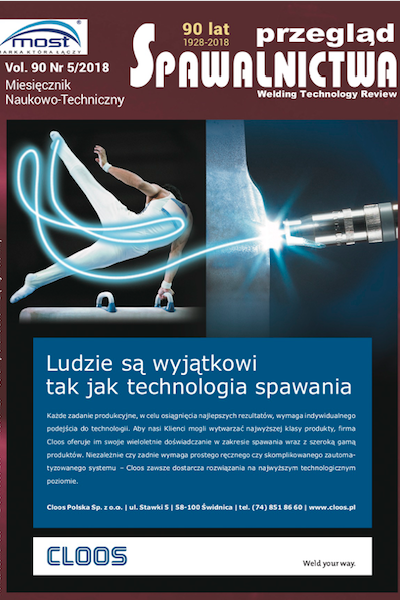Effect of austenitizing temperature on the microstructure and hardness of Hardox 450 steel
##plugins.themes.bootstrap3.article.main##
Abstrakt
The paper presents the simulation of the temperature effect on phase transformation in the heat-affected zone in the area of superheat temperatures. Five different tempera- tures were selected, i.e. 900, 1000, 1100, 1200 and 1300 ÌŠC. Heating and cooling simulations were carried out on the L78 R.I.T.A high-resolution dilatometer. After austenitizing, the samples were cooled with two selected rates 5 and 1 ÌŠC/s. On the samples after cooling, microstructure analysis and hardness distribution analysis were performed. Based on the results, the influence of temperature on the increase of hardenability in the range of the tested cooling rates was determined and as a consequence changes in the microstructure and homogeneity of the obtained hardness maps.
in polish
Wpływ temperatury austenizowania na mikrostrukturę i twardość stali typu Hardox 450
W pracy przedstawiono symulację wpływu temperatury na zakres przemian fazowych w strefie wpływu ciepła w obszarze temperatur przegrzania. Wybrano pięć różnych temperatur austenityzowania, tj.: 900, 1000, 1100, 1200 oraz 1300 ÌŠC. Symulacje nagrzewania i chłodzenia wykonano na wysokorozdzielczym dylatometrze L78 R.I.T.A. Po austenityzowaniu, próbki chłodzono z dwoma wybranymi szybkościami 5 i 1 ÌŠC/s do temperatury pokojowej. Na próbkach po ochłodzeniu wykonano analizę mikrostruktury i twardości. W oparciu o przedstawione wyniki określono wpływ temperatury na hartowność w zakresie badanych szybkości chodzenia i w konsekwencji zmian w mikrostrukturze oraz jednorodności uzyskanych map twardości.
Pobrania
##plugins.themes.bootstrap3.article.details##
Creative Commons CC BY 4.0 https://creativecommons.org/licenses/by/4.0/
Artykuły czasopisma Welding Technology Review (Przegląd Spawalnictwa) publikowane są w otwartym dostępie na licencji CC BY (licencja Creative Commons Uznanie autorstwa 4.0 Międzynarodowe). Licencja CC BY jest najbardziej otwartą dostępną licencją i uważaną za „złoty standard” w formule otwartego dostępu; jest również preferowany przez wielu fundatorów badań. Licencja ta umożliwia czytelnikom kopiowanie i redystrybucję materiału na dowolnym nośniku i w dowolnym formacie, a także zmienianie, przekształcanie lub budowanie na nim materiału, w tym do użytku komercyjnego, pod warunkiem wskazania oryginalnego autora.
Bibliografia
Hardox Das Verschleiβblech der vielen Möglichkeiten, Wydawnictwo SSAB, Oxelösund, 2002.
Dudziński W., Konat Ł., Pękalska L., Pękalski G.: Struktury i właściwości stali Hardox 450 i Hardox 500, Inżynieria Mater. 3, 2006, s. 139-142.
Pękalski G., Konat Ł.: Rozpoznanie i analiza efektów zastosowań stali Hardox, Rap. Inst. Mater. I Mech. Tech. Serii SPR 4/2005.
Pawlak K.: A review of high-strength wear resistant steel hardox, 2015.
Konat Ł., Pękalski G.: Rozpoznanie i analiza efektów zastosowań stali Hardox, Raport PWr serii SPR, 2005.
Malkiewicz T.: Metaloznawstwo stopów żelaza, 2nd ed., PWN, Warszawa Kraków, 1978.
Blicharski M.: Inżynieria materiałowa. Stal, Wydawnictwa Naukowo-Techniczne, Warszawa 2004, n.d.
Sotskov N.I., Goritskii V.M., Morozova L.M.: Effect of Tempering Temperature on The Resistance of High- Strength Steel 40Kh Bolts To Corrosion Cracking, Metalloved. I Termicheskaya Obrab. Met. 292, 1992, pp. 4-7.
Mulholland M.D., Seidman D.N.: Nanoscale co-precipitation and mechanical properties of a high-strength low-carbon steel, Acta Mater. 59, 2011, pp. 1881-1897.
Mikuła J.: Spawalność Stali, Zeszty Naukowe Politechniki Krakowskiej, 2001.
Kostin V.: Microstructure of Haz Metal of Joints of High-Strength Structural Steel Weldox 1300, 2015.
PracaZbiorowa, Poradnik inżyniera spawalnictwo, Wydawnictwo Naukowo-Techniczne, Warszawa, 1983.
Tasak E.: Spawalność stali, FOTOBIT, Kraków, 2002.
